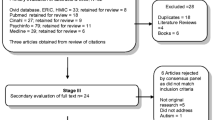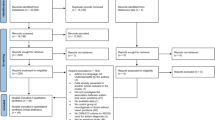Abstract
Evidence of atypical perception in individuals with ASD is mainly based on self report, parental questionnaires or psychophysical/cognitive paradigms. There have been relatively few attempts to establish whether binocular vision is enhanced, intact or abnormal in those with ASD. To address this, we screened visual function in 51 individuals with autistic spectrum disorder and 44 typically developing individuals by measuring visual acuity, stereoacuity, convergence, divergence, ocular motility, incidence of strabismus and integrity of the optokinetic response. The data suggest that many aspects of vision, including visual acuity, are unaffected in ASD, but that convergence is an aspect of visual function that merits further research in those with ASD.



Similar content being viewed by others
Notes
The effect size r is given by
\( r = \frac{Z}{\sqrt N } \)
where Z is the test statistic obtained by Mann–Whitney analysis and N is the total number of data points. Effect sizes of .1, .3 and .5 are considered small, medium and large, respectively (Field 2005).
Because some IQ scores were missing, the data were plotted to ensure that the participants with the lowest base-out prism fusion range scores were not those who were not included in the correlation analysis with IQ. This was not the case, the base-out prism fusion range scores for the high-functioning participants who did not complete the WASI were: 25, 30 & 35 ∆.
References
Ashwin, E., Ashwin, C., Rhydderch, D., Howells, J., & Baron-Cohen, S. (2009). Eagle-eyed visual acuity: An experimental investigation of enhanced perception in autism. Biological Psychiatry, 65, 17–21. doi:10.1016/j.biopsych.2008.06.012.
Cooper, J., & Feldman, J. (1979). Assessing the Frisby Stereo Test under monocular viewing conditions. Journal of the American Optometric Association, 50, 807–809.
Creel, D., Crandall, A. S., Pingree, C., & Ritvo, E. R. (1989). Abnormal electroretinograms in autism. Clinical Vision Sciences, 1, 85–88.
de Jonge, M. V., Kemner, C., de Haan, E. H., Coppens, J. E., van der Berg, T. J. T. P., & van Engeland, H. (2007). Visual information processing in high-functioning individuals with autism spectrum disorders and their parents. Neuropsychology, 21, 65–73. doi:10.1037/0894-4105.21.1.65.
Denis, D., Burillon, C., Livet, M. O., & Burguiere, O. (1997). Ophthalmologic findings in the autistic child. Journal Francais d’Ophtalmologie, 20(2), 103–110.
Ffooks, O. (1965). Vision test for children: Use of symbols. The British Journal of Ophthalmology, 49, 312–314. doi:10.1136/bjo.49.6.312.
Field, A. (2005). Discovering statistics using SPSS (2nd ed.). London: Sage Publications.
Garbutt, S., & Harris, C. M. (2000). Abnormal vertical optokinetic nystagmus in infants and children. British Journal of Orthoptics, 84, 451–455. doi:10.1136/bjo.84.5.451.
Graham, P. A. (1974). The epidemiology of strabismus. The British Journal of Ophthalmology, 58, 224–231. doi:10.1136/bjo.58.3.224.
Gronlund, M. A., Andersson, S., Aring, E., Hard, A. L., & Hellstrom, A. (2006). Ophthalmological findings in a sample of Swedish children aged 4–15 years. Acta Ophthalmologica Scandinavica, 84, 169–176. doi:10.1111/j.1600-0420.2005.00615.x.
Hall, D. M. B., & Elliman, D. (2003). Health for all children. Oxford: Oxford University Press.
Hirsch, M. J. (1963). Changes in astigmatism during the first eight years of school—an interim report from the Ojai Longitudinal study. American Journal of Optometry, 40, 127–132.
Kaplan, M., Rimland, B., & Edelson, S. M. (1999). Strabismus in autism spectrum disorder. Focus on Autism and Other Developmental Disorders, 14, 101–105. doi:10.1177/108835769901400205.
Kay, H. (1983). New method of assessing visual acuity with pictures. The British Journal of Ophthalmology, 67, 131–133. doi:10.1136/bjo.67.2.131.
Kemner, C., van der Geest, J. N., Verbaten, M. N., & van Engeland, H. (2004). In search for neurophysiological markers of pervasive developmental disorders: smooth pursuit eye movements. Journal of Neural Transmission, 111, 1617–1626. doi:10.1007/s00702-004-0164-5.
Lord, C., Risi, S., Lambrecht, L., Cook, E. H., Leventhal, B. L., DiLavore, P. C., et al. (2000). The autism diagnostic observation schedule-generic: A standard measure of social and communication deficits associated with the spectrum of autism. Journal of Autism and Developmental Disorders, 30, 205–223. doi:10.1023/A:1005592401947.
Lord, C., Rutter, M., & Le Couteur, A. (1994). Autism diagnostic interview—Revised: A revised version of a diagnostic interview for caregivers of individuals with possible pervasive developmental disorders. Journal of Autism and Developmental Disorders, 24, 659–685. doi:10.1007/BF02172145.
Milne, E., & Griffiths, H. (2007). Visual perception and visual dysfunction in autistic spectrum disorder: A literature review. British and Irish Orthoptics Journal, 4, 15–20.
Milne, E., Swettenham, J., Hansen, P., Campbell, R., Jeffries, H., & Plaisted, K. (2002). High motion coherence thresholds in children with autism. Journal of Child Psychology and Psychiatry, and Allied Disciplines, 43, 255–263. doi:10.1111/1469-7610.00018.
Minshew, N. J., Luna, B., & Sweeney, J. A. (1999). Oculomotor evidence for neocortical systems but not cerebellar dysfunction in autism. Neurology, 52, 917–922.
Mottron, L., Dawson, M., Souliėres, I., Hubert, B., & Burack, J. A. (2006). Enhanced perceptual functioning in autism: An Update and eight principles of autistic perception. Journal of Autism and Developmental Disorders, 36, 27–43. doi:10.1007/s10803-005-0040-7.
Mottron, L., Mineau, S., Martel, G., St-Charles Bernier, C., Berthiaume, C., Dawson, M., et al. (2007). Lateral glances toward moving stimuli among young children with autism: Early regulation of locally oriented perception? Development and Psychopathology, 19, 23–26. doi:10.1017/S0954579407070022.
O’Connor, A. R., Stephenson, T. J., Johnson, A., Tobin, M. J., Ratib, S., Moseley, M., et al. (2004). Visual function in low birthweight children. The British Journal of Ophthalmology, 88, 1149–1153. doi:10.1136/bjo.2003.035154.
O’Riordan, M., Plaisted, K., Driver, J., & Baron-Cohen, S. (2001). Superior visual search in autism. Journal of Experimental Psychology. Human Perception and Performance, 27, 719–730. doi:10.1037/0096-1523.27.3.719.
Plaisted, K., O’Riordan, M., & Baron-Cohen, S. (1998). Enhanced visual search for a conjunctive target in autism: A research note. Journal of Child Psychology and Psychiatry, and Allied Disciplines, 39, 777–783. doi:10.1017/S0021963098002613.
Robaei, D., Huynh, S. C., Kifley, A., Gole, G. A., & Mitchell, P. (2007). Stereoacuity and ocular associations at age 12 years: Findings from a population-based study. Journal of AAPOS: The Official Publication of the American Association for Pediatric Ophthalmology and Strabismus/American Association for Pediatric Ophthalmology and Strabismus, 11(4), 356–361.
Rogers, S. J., & Ozonoff, S. (2005). Annotation: What do we know about sensory dysfunction in autism? A critical review of the empirical evidence. Journal of Child Psychology and Psychiatry, and Allied Disciplines, 46, 1255–1268. doi:10.1111/j.1469-7610.2005.01431.x.
Scharre, J. E., & Creedon, M. P. (1992). Assessment of visual function in autistic children. Optometry and Vision Science, 69, 433–439. doi:10.1097/00006324-199206000-00004.
Schopler, E., Reichler, R. J., & Renner, B. R. (1988). The childhood autism rating scale. Los Angeles: Western Psychological Services.
Shah, A., & Frith, U. (1983). An islet of ability in autistic children: A research note. Journal of Child Psychology and Psychiatry, and Allied Disciplines, 24, 613–620. doi:10.1111/j.1469-7610.1983.tb00137.x.
Skjeldal, O. H., Sponheim, E., Ganes, T., Jellum, E., & Bakke, S. (1998). Childhood autism: The need for physical investigations. Brain & Development, 20(4), 227–233. doi:10.1016/S0387-7604(98)00031-X.
Stayte, M., Reeves, B., & Wortham, C. (1993). Ocular and vision defects in pre-school children. The British Journal of Ophthalmology, 77, 228–232. doi:10.1136/bjo.77.4.228.
Stuart, J., & Burian, H. (1962). A study of separation difficulty: Its relationship to visual acuity in normal and amblyopic eyes. American Journal of Ophthalmology, 53, 471–477.
Takarae, Y., Minshew, N., Luna, B., Krisky, C. M., & Sweeney, J. A. (2004). Pursuit eye movement deficits in autism. Brain, 127, 2584–2594. doi:10.1093/brain/awh307.
von Noorden, G. K., & Campos, E. C. (2002). Binocular vision and ocular motility. Theory and management of Strabismus (6th ed.). St Louis, MO: Mosby.
Wechsler, D. (1999). Wechsler abbreviated scale of intelligence. San Antonio, TX: The Psychological Corporation.
Zadnik, K., Mutti, D. O., & Adams, A. J. (1992). Astigmatism in children: What’s the rule? Ophthalmic and Visual Optics Technical Digest, 3, 68–71.
Acknowledgments
We thank David Burton, Bhavna Singh and Charlotte Westerman for assistance with data collection and for useful discussions about the work presented here. We are grateful to all participants, Rowan Primary School, Nook Lane Primary School, Bents Green Secondary School, Dobcroft Junior School, All Saints Catholic High School, Alderwasley Hall School, Fullerton House School and Wilsic Hall School for generously giving their time to participate in the research. This work was supported by the Economic and Social Research Council (research grant RES-000-22-1868) and has been presented in part at the following meetings: Autism Research, UK (Milton Keynes, 2007), the 8th International Congress of Autism Europe (Norway, 2007) and the XI International Orthoptic Congress (Antwerp, 2008).
Author information
Authors and Affiliations
Corresponding author
Rights and permissions
About this article
Cite this article
Milne, E., Griffiths, H., Buckley, D. et al. Vision in Children and Adolescents with Autistic Spectrum Disorder: Evidence for Reduced Convergence. J Autism Dev Disord 39, 965–975 (2009). https://doi.org/10.1007/s10803-009-0705-8
Received:
Accepted:
Published:
Issue Date:
DOI: https://doi.org/10.1007/s10803-009-0705-8




